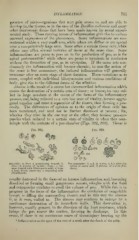Page 691 - My FlipBook
P. 691
INFLAMMA TION. 701
presence of micro-organisms that may gain access to, and are able to
develop in, the tissues, as in the case of the Bacillus anthracis and many
other microscopic forms that have been made known by recent experi-
mental study. These varying causes of inflammation give rise to various
outward expressions of the phenomena. Some inflammations are con-
centrated within a very small area, while others are diff'use or are spread
over a comparatively large area. Some aflect a certain tissue only, while
others may affect several varieties of tissue at the same time. Some
inflammations are prone to pass on to the production of pus, as is the
apical pericementitis,' while others are prone to terminate in resolution
without the formation of pus, as in erysipelas. If the cause acts con-
tinuously the inflammation will become chronic ; in case the action of
the cause is but momentary, the induced inflammation will generally
terminate after an acute stage of short duration. These variations as to
cause, coupled with individual idiosyncrasies and various conditions of
body, give rise to the different forms of the affection.
Abscess is the result of a severe but circumscribed inflammation which
causes the destruction of a certain area of tissue ; or leucocytes may col-
lect in large numbers at the centre of the focus of the inflammatory
process, and, being reduced to a very low state of vitality, become aggre-
gated together and cause a separation of the tissues, thus forming a jnis-
cavity. The differences of opinion as to the origin of these cells has
been mentioned, and need not be further discussed at present ; for,
whether they arise in the one way or the other, they become pus-cor-
puscles when reduced to a certain state of vitality or when they com-
mingle with the contents of a pus-chamber (Figs. 392, 393). Tissue is
Fig. 392. Fig. 393.
Pus-cells: a, from a granulating wound; ft, Pus corpuscles : 1,n,h. in water; c, (7, e, after the
from an abscess of cellular tissue; c, the action of acetic acid; 2, divisiou of nuclei (Vir-
same treated with dilute acetic acid ; d, from chow).
a bone fistula (necrosis); e, migrating cells
(Rindfleisch).
usually destroyed in the focus of an intense inflammation, and, becoming
dissolved or forming small gangrenous masses, mingles with the fluid
and corpuscular exudates to swell the volume of pus. While this is in
progress in the focus of the inflammation the exudation of coagulable
lymph is filling the surrounding tissues, and in this way the abscess
is, as it were, walled in. The abscess may continue to enlarge by a
continuous destruction of its immediate walls. This destruction is,
however, usually greatest in the direction of the least resistance, which
brings the pus nearer the surface, favoring its discharge. In this
event, if there is no continuous cause of tissue injury keeping up the
^ Inflammation at the apex of the I'oot of a tooth after the death of the pulp.


